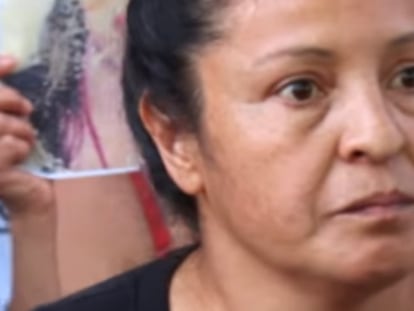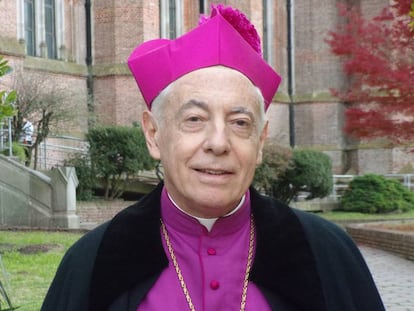‘Debanhi Escobar case’ reveals new wave of femicides in Mexico
The recent discovery of two bodies outside Monterrey adds to the dozens of women who have gone missing in the area, in a trend that is reminiscent of events in Ciudad Juárez in the 1990s
The body of 18-year-old Debanhi Escobar, which was found last Thursday in the cistern of a motel in in the suburbs of Monterrey after a week-long search, and that of María Fernanda Contreras, 26, discovered on April 9 just a few miles away, have uncovered a new wave of femicides and disappearances in northeastern Mexico. The periphery surrounding this prosperous city in the state of Nuevo León, the industrial heartland of the country, has become a sinister corner of Mexico for half of the population: at least 41 women have disappeared from the suburbs of Monterrey since the beginning of 2022 and more than 1,700 have been reported missing across the entire state, according to official figures. In a series of crimes that have revived the darkest period of femicides in Mexico’s history, Las muertas de Juárez (the dead women of Ciudad Juárez) are now the dead of Nuevo León.
The increase in the disappearances of young women in Nuevo León - mostly teenagers and almost all under 30 – has handed the state administration of Samuel García a crisis. The discovery of Contreras’ body to the north of Monterrey led to a string of protests, fires being set at the seat of the state government and media pressure that led García, who assumed office at the end of last year, to set up a special task force to search for Debanhi Escobar. García hinted, in the midst of the crisis, that the disappearances of so many women may have been “aggravated by Covid-19, with mental health problems and a lack of opportunities,” while seemingly ruling out the involvement of organized crime gangs and attempting to play down an emergency that has strained relations between the state government and the citizenry more than ever.
The eventual discovery of Escobar’s body last week just meters away from where she was last seen getting out of a cab, in front of the Nueva Castilla motel, has stirred up anger across Mexico. The establishment was searched by police on at least four occasions during the 13-day search for Escobar and her body, according to the Public Prosecutor’s Office, had been there all the time, in an open-air cistern. The secretary for State Security of Nuevo León, Aldo Fasci, described the failure to discover the young woman’s body sooner a “massive human failure.”
The Nueva Castilla motel was the main focus of the investigation from the outset: it was last place she used her cellphone and the last place she took a photograph, at 5am on April 9. The search parties, which included dozens of volunteers, dogs and drones, met at the motel every morning to plan out the day’s raids on other locations. Escobar’s family had also set themselves up there in a makeshift camp, with a photograph of their daughter. “Thirteen days here! How many times were you here looking?” her father shouted at the authorities removing the body from the motel on the night his daughter was found.
Another woman who remains missing is Yolanda Martínez, 26 and mother to a three-year-old daughter, who disappeared on March 31 in the municipality of San Nicolás Garza, which is also within the Monterrey metropolitan area. Her father, Gerardo Martínez, told the media that she had left his house that day in search of work and had never returned. There are many more. Allison Campos, 12, who has been missing since March 28. The last time she was seen was in the San Gilberto area of Santa Catarina, in white tennis shoes and a gray sweater. Within a radius of just a few miles, Paulina Solís and Celeste Tranquilino, both 16, Karen Valencia, 24, Diana Cardenas, 28, and Yolanda González, 32, have all gone missing. The police also failed to find any trace of Sofía Sauceda, 15, who disappeared on March 16 in Ciudad Terán, less than 60 miles from Monterrey.
So far in 2022, 52 women have disappeared in Nuevo León, according to the latest figures. Of those, 41 were reported missing from the metropolitan area of Monterrey, which includes the state capital and a dozen satellite municipalities. In the past 50 years, 1,790 women have gone missing in Nuevo León, according to the national missing persons registry. Of that number, 90% have disappeared since 2010.
As happened in Ciudad Juárez during a wave of femicides in the 1990s, it has been left to the families to pressure the authorities from the outset, which has laid bare a litany of inaction, lethargy and even irregularities, as in the case of María Fernanda Contreras. Her father, Luis Carlos Contreras, spent hours driving around the area where he believed his daughter had disappeared, while the authorities asked him to wait, the family stated on social media. Mario Escobar, Debanhi’s father, said last week shortly after his daughter was found: “I made a mistake: I believed in the Public Prosecutor. They never gave me the files [of the investigation]. I asked for copies, as is my right as a victim. I never had them in my possession because they did not do their job. I demand justice.”
Mexico is locked in a spiral of violent crime against women that costs 11 lives per day. The international scandal caused by Las muertas de Juárez spread to other cities, such as Ecatepec, in the state of Mexico, where a spate of killings reached 600 victims in total by 2016. In Mexico, 95% of crimes are never solved, according to a report based on official data by the independent public watchdog México Evalúa. In the case of women who disappear, impunity is “practically absolute,” the United Nations Human Rights Committee has stated.
“What is plain to see is that they continue to make us disappear because they can,” says Angélica Orozco of Fuerzas Unidas por Nuestros Desaparecidos de Nuevo León (United Forces for our Disappeared of Nuevo León), the state’s leading search organization. “Nobody has been held responsible and there were no punishments for those who committed these crimes previously, nor for those who have obstructed justice. Under these conditions they can continue to kill us, whether it be the drug cartels or anyone else.”
Orozco adds that the crisis of disappearances in Nuevo León cannot be interpreted as “isolated incidents.” All of the victims are young and went missing in the Monterrey metropolitan area, which reminds the activist of another case in the rural municipality of Sabinas Hidalgo, some 60 miles from the state capital. In three months from August to October last year, at least 11 young women disappeared in Sabinas Hidalgo. Of those, the authorities found only three, all of them killed. “Some of them knew each other. We told the authorities they should look into a possible trafficking ring. But they did nothing. They wanted to investigate the deaths as individual cases,” Orozco says, warning that something similar could occur with the spate of recent disappearances in Monterrey.
Tu suscripción se está usando en otro dispositivo
¿Quieres añadir otro usuario a tu suscripción?
Si continúas leyendo en este dispositivo, no se podrá leer en el otro.
FlechaTu suscripción se está usando en otro dispositivo y solo puedes acceder a EL PAÍS desde un dispositivo a la vez.
Si quieres compartir tu cuenta, cambia tu suscripción a la modalidad Premium, así podrás añadir otro usuario. Cada uno accederá con su propia cuenta de email, lo que os permitirá personalizar vuestra experiencia en EL PAÍS.
¿Tienes una suscripción de empresa? Accede aquí para contratar más cuentas.
En el caso de no saber quién está usando tu cuenta, te recomendamos cambiar tu contraseña aquí.
Si decides continuar compartiendo tu cuenta, este mensaje se mostrará en tu dispositivo y en el de la otra persona que está usando tu cuenta de forma indefinida, afectando a tu experiencia de lectura. Puedes consultar aquí los términos y condiciones de la suscripción digital.
More information
Últimas noticias
Tiger Woods turns 50: Will he continue playing on the PGA Tour or take a back seat?
The surreal journey of James Nnaji, the Barcelona youth player selected in the NBA Draft who ended up in the NCAA
Trump claims peace in Ukraine is near, but Moscow suggests otherwise
A survivor’s account of the Interoceanic Train accident: ‘We were scared because of the speed on the curve’
Most viewed
- Oona Chaplin: ‘I told James Cameron that I was living in a treehouse and starting a permaculture project with a friend’
- Reinhard Genzel, Nobel laureate in physics: ‘One-minute videos will never give you the truth’
- Why the price of coffee has skyrocketed: from Brazilian plantations to specialty coffee houses
- Pablo Escobar’s hippos: A serious environmental problem, 40 years on
- Chevy Chase, the beloved comedian who was a monster off camera: ‘Not everyone hated him, just the people who’ve worked with him’











































